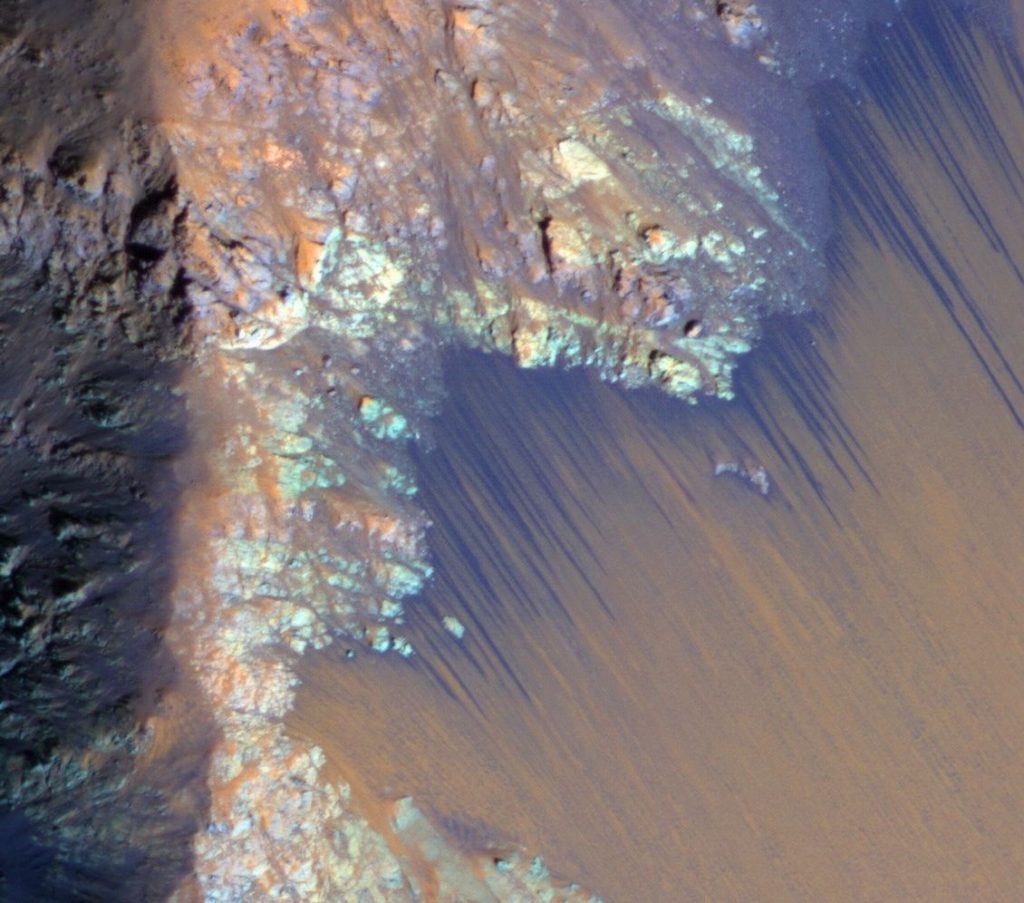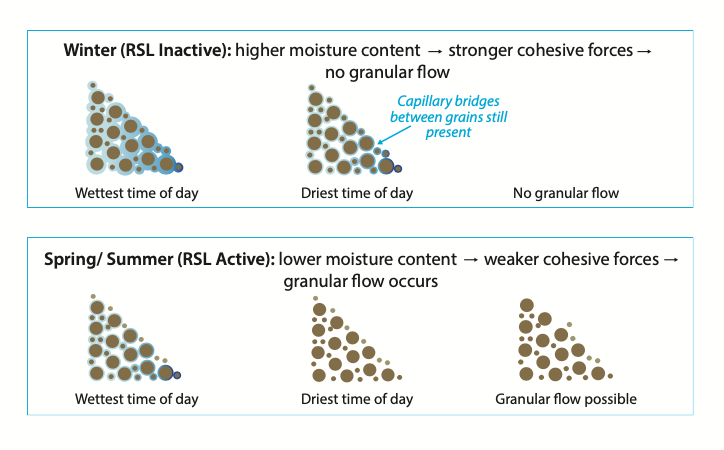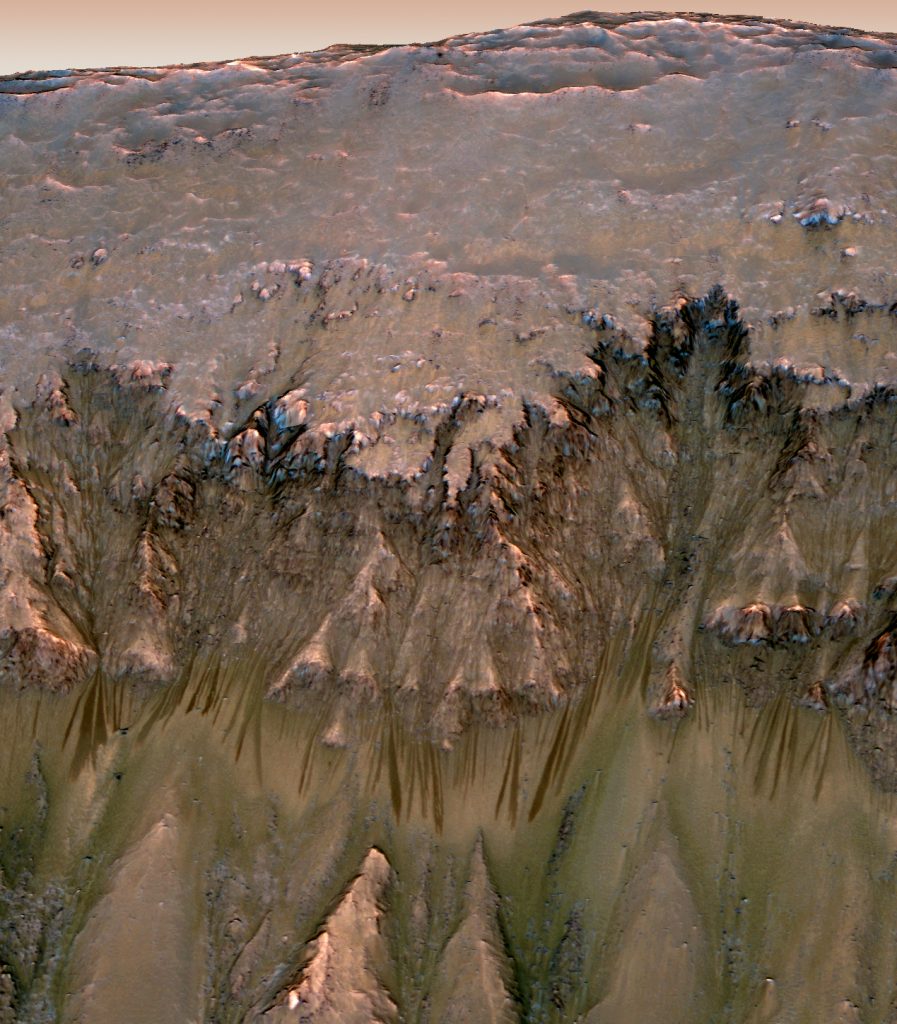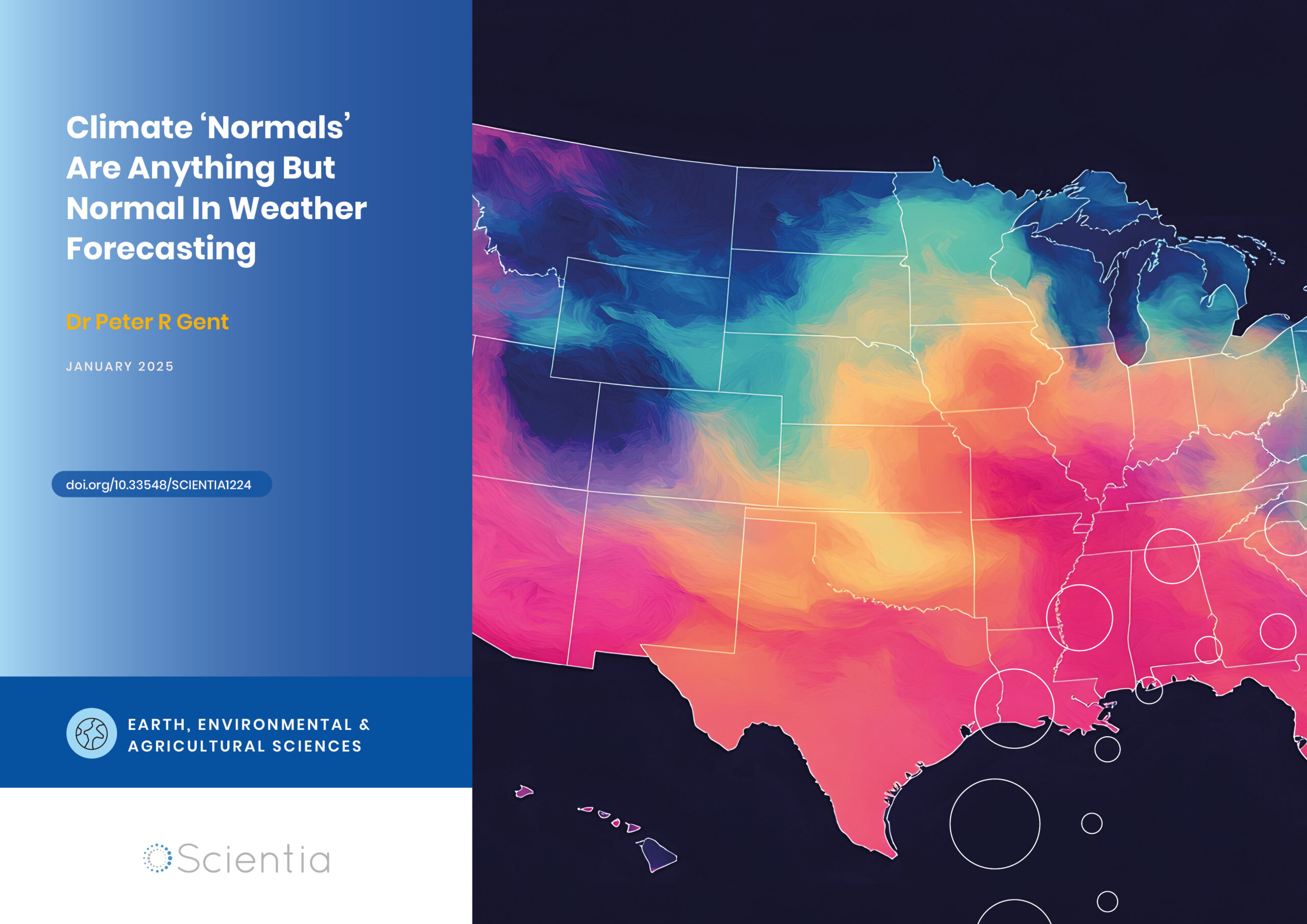Dr Anthony Toigo – Revealing the Trigger for Martian Avalanches
For years, scientists have been puzzled by the appearance of dark streaks appearing on Martian hillsides. The linear features look like water flows – and if water is present, they could be harbouring life on Mars. However, the freezing conditions on Mars mean that liquid water flows are unlikely. Previous theories suggest the flows could be dust avalanches, but this doesn’t explain why they only appear in the Martian summer. Dr Anthony Toigo and his colleagues at Johns Hopkins University Applied Physics Laboratory, NASA Goddard Space Flight Center, and the University of Colorado – Boulder, have modelled weather conditions near the Martian surface and recreated the Martian atmosphere in a laboratory. By doing so, they could examine how Martian dust and surface soils respond to the changing seasons on the red planet.
Mysterious Dark Streaks on Mars
Every year, in the Martian summer, dark streaks begin to appear on the steepest hillsides, such as valley walls and the rims of ancient meteor craters. The lines are visible in images taken by Mars orbiters, and scientists refer to them as ‘recurring slope lineae’, or RSLs. The streaks grow slowly throughout the summer and then disappear when the Martian weather gets colder.
Scientists initially assumed that these RSLs were wet, as they look like flows of water. As liquid water is essential for life, the flows could be sites for ancient or even current biological activity on Mars. If the sites were home to alien life forms on Mars, they would be a top priority in efforts to protect and preserve the planet’s environment.
Liquid-carved features on the surface of Mars indicate that ancient rivers once flowed on the red planet. However, scientists generally agree that for about the last 3.5 billion years, temperatures on Mars have been too cold for pure water to exist as a liquid. Water could only flow in the form of very salty brine, as salt dissolved in water lowers its freezing temperature.
Any water in the RSLs could come from either frozen or liquid aquifers underground. However, the dark streaks sometimes appear on isolated peaks and ridges, which are unlikely to store underground water. Alternatively, water vapour from the atmosphere could be absorbed by the Martian soil. Still, it has previously been unclear how atmospheric water vapour could trigger seasonal avalanches.
If water on the Martian hillsides comes from atmospheric vapour, the sites would be unlikely to contain life. Understanding whether water could trigger these flows and where it could come from is an essential first step in determining whether these sites could harbour life.
Dr Anthony Toigo at the Johns Hopkins University Applied Physics Laboratory has devoted years to investigating the causes of Martian RSLs. His team’s latest work aimed to determine whether RSLs could be caused by water vapour absorbed from the Martian atmosphere rather than liquid water flows. If the streaks could form without liquid water, scientists may have to look elsewhere for life on Mars.

CREDIT: Lunar and Planetary Laboratory/NASA
Simulating the Martian Atmosphere
At Hale Crater on Mars, the site of an ancient meteorite impact, dark streaks form every year. The flows start growing in early spring on the steep slopes of the crater walls and fade away in the Martian winter. To understand whether atmospheric water vapour could be causing the streaks, Dr Toigo and his team set out to understand the temperature and humidity conditions at the site.
Spacecraft orbiting around Mars, such as the Mars Reconnaissance Orbiter, pass by Hale Crater at approximately the same time every Martian day and measure atmospheric conditions, but Dr Toigo’s group wanted to understand how atmospheric conditions changed throughout the whole day. Furthermore, the orbiters cannot detect humidity in the lower layers of the atmosphere nearest the surface of Mars.
To fill the gap between observations, they used mathematical models to predict how temperature and humidity would change throughout the Martian day. They forecasted the daily temperature and humidity cycles at the crater in the summer months, when the flows appear, and the winter months, when they are absent. Their results show that temperatures at the crater are very cold; even during the summer, they typically remain below freezing.
Once they had estimated the Martian conditions, the team replicated the Martian atmosphere in the lab. This was the first time that daily-varying environmental conditions at Martian avalanche locations were simulated on Earth. Firstly, the researchers tested whether the streaks could be brine flows triggered by a process called deliquescence. In this process, salts in the Martian soil would absorb enough atmospheric water vapour to dissolve in the absorbed water, forming a concentrated salt solution.

Next, the group studied a type of salt found in the Martian soil, called calcium perchlorate, subjecting it to Martian temperature and humidity conditions in their lab. To do this, they encased the salts in a cell with controlled temperature and humidity, cooling the samples using liquid nitrogen and humidifying it with water vapour. They then directed a laser at the samples and measured how they scattered the laser light, to find out how much absorbed water or ice they contained.
In both the summer and winter experiments, the conditions were sufficiently cool and humid for water to be absorbed by the salt overnight. However, the salts did not take in enough water to form a liquid brine. Therefore, Dr Toigo and his colleagues deduced that the flows on Mars could not be brine flows created by water absorption from the atmosphere into the soil.
However, they noticed an interesting difference between the two sets of experiments. The salt absorbed water overnight and released it back to the atmosphere during the day, but only lost all of its water in Martian summer conditions, when the dark flows form. In contrast, in the Martian winter conditions, even in the warmest time of day, the salt did not completely dry out. ‘When the RSLs are seasonally active, the ground is drying,’ says Dr Toigo.
The researchers formed a new hypothesis for how atmospheric water vapour could trigger flows on the crater walls in the summer, without the need for liquid brine. Instead of a fluid flow, the dark streaks could be dry avalanches of dust caused by salts in the Martian soil drying out in the summer.

Illustration showing the trigger mechanism for RSLs
The Trigger for Martian Avalanches
The warm, dry conditions at Hale Crater in the late spring and summer could cause the salts in the soil to completely dry out during the warmest part of the day. When the soil dries out, the cohesive forces between the grains, which usually hold them together, weaken. The Martian soil becomes less sticky and more prone to sliding downhill. ‘When the soil seasonally starts drying, it becomes more loose and more likely to collapse, like a dry landslide,’ explains Dr Toigo.
When this happens, the bright-coloured dust and sand slide down steep slopes such as the walls of Hale Crater. ‘This collapse would expose darker material underneath, appearing as the discolouration seen in the images taken by spacecraft,’ adds Dr Toigo.
More dust from the atmosphere is deposited on the slopes in the winter, and the temperature never becomes warm enough to dry it out. The soil grains have a high moisture content all day, and the cohesive forces between the grains prevent them from flowing downhill.
The streaks could plausibly be caused by dry dust avalanches, as they occur on slopes steep enough for dry material to flow. Some scientists had previously suggested that they could be dry flows caused by wind disturbing the dust or gas flowing under the soil, but these theories can’t explain why the flows only appeared in the warm months. The absorption and release of atmospheric water by salts in the ground are possible under Martian conditions and explain the flows’ seasonality.
If yearly dust fall provides the material for the flows, they could be very thin – possibly only a fraction of a millimetre in depth. Dr Toigo’s model suggests that the subsurface could be dehydrated up to a depth of about six centimetres. However, if the surface dust is much brighter than the rocky ground underneath, even a tiny, thin flow could easily be observed from space.

CREDIT: NASA/JPL-Caltech/University of Arizona
Is Mars Currently Habitable?
Dr Toigo’s team found that the dark streaks on Martian hillsides could be dry dust avalanches, where surface grains are normally held together by the absorption of atmospheric water vapour at night by salts in the soil, and then become looser by a drying of the ground during the warmest parts of the day. The theory explains why the flows are only observed in the summer, as the salts can only completely dry out in the summer, and then the dust is loosest and avalanches can be most easily started.
It remains unknown why the flows are common on some slopes, such as Hale Crater, but not others. However, if the atmospheric vapour theory is correct, the variation could be explained by locally varying temperatures or salt concentrations in the soil.
The atmospheric vapour theory has important implications for the search for life on Mars. ‘If RSLs can form from the seasonal absorption of water vapour in the air instead of from underground reservoirs of water, then areas where RSLs are found would not be locations of likely biological activity,’ explains Dr Toigo.
The findings could have implications for the protection status of the flows. If they do not contain liquid water and are unlikely to be habitable, they could be suitable sites for future exploration by landing probes. However, anyone on a mission to find life on Mars might be disappointed. ‘The search for life on Mars would best be conducted elsewhere,’ concludes Dr Toigo.
Reference
https://doi.org/10.33548/SCIENTIA674
Meet the researcher

Dr Anthony Toigo
Applied Physics Laboratory
Johns Hopkins University
Laurel, MD
USA
Dr Anthony Toigo obtained his PhD in planetary science at the California Institute of Technology, where his research focused on atmospheric processes on Mars. After graduating in 2001, he continued to study the Martian atmosphere as a Research Associate at Cornell University, New York, and subsequently as an International Scholar at Kobe University, Japan. In 2009, Dr Toigo moved to the Johns Hopkins University Applied Physics Laboratory, where he currently develops software and conducts research analysing spacecraft observations and computer models. Dr Toigo has dedicated his career to understanding planetary atmospheres, and his work has furthered our understanding of the Martian atmosphere and climate, Martian dust storms, and the atmosphere on Pluto. Alongside his academic research, he contributed to verifying landing and operating conditions for several Mars spacecraft. Dr Toigo has been awarded multiple prestigious grants and awards for his contributions to planetary science.
CONTACT
E: Anthony.Toigo@jhuapl.edu
W: http://crism.jhuapl.edu/mission/team.php
KEY COLLABORATORS
Scott D. Guzewich, NASA Goddard Space Flight Center
Raina V. Gough, University of Colorado, Boulder
Danielle L. Nuding, Johns Hopkins University Applied Physics Laboratory
FUNDING
National Aeronautics and Space Administration (NASA)
- NRA/Research Opportunities in Space and Earth Sciences – 2015 (ROSES-2015) Solar System Workings (SSW) Grant NNX16AR89G, ‘Investigating Atmospheric Sources of Water of Recurring Slope Lineae on Mars’
Mars Reconnaissance Orbiter (MRO) Compact Reconnaissance Imaging Spectrometer for Mars (CRISM)
- http://crism.jhuapl.edu
- NASA instrument built and operated by the Johns Hopkins University Applied Physics Laboratory onboard NASA mission
FURTHER READING
RV Gough, DL Nuding, PD Archer Jr, MS Fernanders, SD Guzewich, MA Tolbert, AD Toigo, Changes in soil cohesion due to water vapor exchange: a proposed dry‐flow trigger mechanism for recurring slope lineae on Mars, Geophysical Research Letters, 2020, 47, e2020GL087618.

Want to republish our articles?
We encourage all formats of sharing and republishing of our articles. Whether you want to host on your website, publication or blog, we welcome this. Find out more
Creative Commons Licence
(CC BY 4.0)
This work is licensed under a Creative Commons Attribution 4.0 International License. 
What does this mean?
Share: You can copy and redistribute the material in any medium or format
Adapt: You can change, and build upon the material for any purpose, even commercially.
Credit: You must give appropriate credit, provide a link to the license, and indicate if changes were made.
More articles you may like
Dr Peter Gent | Climate ‘Normals’ Are Anything But Normal In Weather Forecasting
Weather forecasters and meteorologists have long used the term ‘climate normal’ to describe average temperatures, but this seemingly innocuous phrase might be causing widespread public misunderstanding. New research suggests that describing temperature data as ‘normal’ leads many people to incorrectly assume these values represent the most common or expected temperatures when, in reality, actual temperatures regularly deviate significantly from these averages.
Revolutionary Battery Technology Promises to Transform Energy Storage
The world of energy storage is on the cusp of a significant breakthrough. As society increasingly shifts towards electrification, from personal devices to transportation and beyond, the limitations of current battery technology have become increasingly apparent. An innovative company in Tallahassee, Florida, is developing a revolutionary new battery that could transform how we store and use energy. The technology, developed by a team of experts at Piersica Inc., promises to deliver an energy density of 630 watt-hours per kilogram (Wh/kg)—approximately two and a half times higher than current lithium-ion batteries. This advancement will extend the range of electric vehicles, enable long-distance electric aircraft, and dramatically increase the battery life of portable electronics.
Dr Maka Tsulukidze – Dr David Reardon | After the Loss: Exploring Cardiovascular Risks Linked to Pregnancy Loss
Carrying a pregnancy is associated with numerous health problems, but little is known about the impact of pregnancy loss on heart health. Dr Maka Tsulukidze from the Florida Gulf Coast University, Dr David Reardon, based at the Elliot Institute, and Dr Christopher Craver at the Charlotte Lozier Institute in Arlington, conducted research into the adverse effects of pregnancy loss on heart function and health. In particular, their research focused on the impact of pregnancy loss on the risk of cardiovascular diseases.
Dr Zhi-yong Huang | The Scientific Hepatectomy: Pioneering Approaches for Tackling Liver Cancer
Cancer research is an ever-evolving field of science fuelled by the pressure of the ongoing need to find new approaches to tackle this killer. Dr Zhi-yong Huang is based at the Tongji Medical College at Huazhong University of Science and Technology in China. He works tirelessly to develop novel treatments for diseases of the liver and biliary system, with a particular focus on liver cancer surgery. He has pioneered methods to optimise the treatment of this type of cancer.




